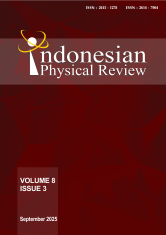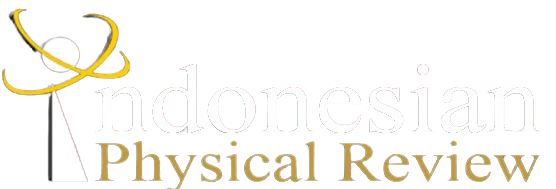NUMERICAL SIMULATION OF Mw 8.3 SOUTH BURU FAULT TSUNAMIS WITH 3D SLIP EVOLUTION IN AMBON
DOI:
10.29303/ipr.v8i3.541Downloads
Abstract
This study investigates the tsunami hazard potential induced by the activity of the South Buru Thrust Fault on the coastal areas of Ambon City through two-dimensional (2D) numerical modelling using the COMCOT v1.7 software, while incorporating three-dimensional (3D) slip evolution from the fault scenario. The earthquake scenario was set at Mw 8.3 based on fault length, width, and slip potential estimates, representing an extreme seismic event in the region. By integrating 3D slip evolution into the 2D tsunami model, the approach accounts for spatial variations in vertical displacement along the fault plane, directly influencing tsunami generation and propagation. The simulation results show significant spatial variations in tsunami run-up heights and inundation zones, with maximum run-up recorded at Kapahaha (13.08 m, arrival time ~832 s) and Slamet Riyadi Port (12.02 m, arrival time ~786 s). In comparison, minimum values occurred in Ambon's northern and northeastern parts (<1 m). The affected area and inundation distance from the shoreline also vary, e.g., Kapahaha (12,813 m², 159 m) and Slamet Riyadi Port (414,158 m², 1,213 m). Areas experiencing the highest tsunami inundation are Latuhalat (>5 m), followed by Galala–Wayame–Laha (3–5 m) and Paso–Rumah Tiga–Hative Kecil (2–4 m). The distribution of tsunami waves is influenced by coastal morphology, wave direction, and the presence of bays and capes, which can either amplify or block waves. Further analysis highlights the effects of seafloor topography, coastal morphology, and wave propagation pathways on run-up heights and arrival times. These findings underscore the importance of considering multi-segment rupture models, 3D deformation, and coastal morphology in tsunami hazard assessments and contribute to more realistic, source-specific mitigation strategies in tectonically complex regions such as Ambon.Keywords:
South Buru Fault numerical modeling tsunami run-up tsunami inundation Ambon coastal areaReferences
[1] R. Hall, “Cenozoic geological and plate tectonic evolution of SE Asia and the SW Pacific: computer-based reconstructions, model and animations,” Journal of Asian Earth Sciences, vol. 39, no. 4, pp. 229–244, 2012.
[2] Y. Tanioka and K. Satake, “Tsunami generation by horizontal displacement of ocean bottom,” Geophysical Research Letters, vol. 23, no. 8, pp. 861–864, 1996.
[3] C. J. Westen, “Local tsunami early warning systems in the context of risk management,” Journal of Disaster Research, vol. 6, no. 2, pp. 104–113, 2011
[4] S. L. Soloviev and C. N. Go, Catalogue of Tsunamis on the Western Shore of the Pacific Ocean. Canada: Canadian Translation of Fisheries and Aquatic Sciences, no. 5078, 1984, 310 p, 1984.
[5] BMKG, “Gempa Bumi 5.0 SR Laut Banda, 2 Oktober 2023,” Badan Meteorologi, Klimatologi, dan Geofisika, Jakarta, 2023. [Online]. Available: https://www.bmkg.go.id. [Accessed June 28, 2025].
[6] D. Renaldi, P. Wijayanti, and A. Fitriyani, “Analisis risiko tsunami di wilayah pesisir Ambon menggunakan metode multi-criteria analysis,” Jurnal Geografi, vol. 20, no. 1, pp. 55–66, 2023.
[7] T. Arikawa, K. Shimosako, T. Tomita, T. Takabatake, and M. Esteban, “Characteristics of tsunami propagation and inundation in Onagawa Bay due to the 2011 Tohoku earthquake,” Coastal Engineering Journal, vol. 61, no. 1, pp. 31–52, 2019.
[8] I. R. Pranantyo and P. R. Cummins, “The 1674 Ambon tsunami: Extreme run-up caused by an earthquake-triggered landslide,” Pure and Applied Geophysics, vol. 177, no. 5, pp. 1641–1656, 2020.
[9] L. Shao, Y. Yu, Y. Cheng, and J. Zhang, “Numerical simulation of tsunami wave run-up in different coastal topographies,” Natural Hazards, vol. 107, pp. 2143–2163, 2021.
[10] H. Yeh, I. N. Robertson, and J. Preuss, “Development of tsunami-resilient communities,” Earthquake Spectra, vol. 21, no. S1, pp. 367–371, 2005.
[11] M. J. Briggs, C. E. Synolakis, G. S. Harkins, and D. R. Green, “Laboratory experiments of tsunami run-up on a circular island,” Pure and Applied Geophysics, vol. 144, no. 3–4, pp. 569–593, 1995.
[12] R. Hidayat, J. Sopaheluwakan, and A. D. Nugraha, “Tsunami hazard assessment in Banda Sea region,” Journal of Disaster Research, vol. 15, no. 7, pp. 972–981, 2020.
[13] A. R. Gusman, K. Satake, and K. Goda, “Probabilistic tsunami hazard in Indonesia due to active fault sources,” Pure and Applied Geophysics, vol. 179, no. 2, pp. 677–698, 2022.
[14] Y. Noya, I. Meilano, I. Pranantyo et al., “Tsunami threat from the Seram Fault system,” Natural Hazards and Earth System Sciences, vol. 23, pp. 943–958, 2023.
[15] P. L.-F. Liu, S. B. Woo, and Y. S. Cho, Computer programs for tsunami propagation and inundation, Ithaca, NY: Cornell University, no. 98-01, 1998, 85 p, 1998.
[16] X. Wang, COMCOT User Manual Version 1.7, Ithaca, NY: Cornell University, 37 p, 2009.
[17] K. Kajiura dan N. Shuto, “Tsunami numerical simulation,” in Handbook of Coastal Disaster Mitigation for Engineers and Planners, Tokyo: University of Tokyo Press, pp. 151–166, 1990.
[18] L. Li, X. Deng, and H. Liu, “Numerical simulation of tsunami inundation with varying bottom friction,” Natural Hazards and Earth System Sciences, vol. 13, no. 11, pp. 2835–2848, 2013.
[19] G. S. Prasetya, T. M. Wilson, and W. L. Power, “Tsunami modeling for local sources in Indonesia,” Natural Hazards and Earth System Sciences, vol. 11, no. 12, pp. 3233–3246, 2011.
[20] T. Lay, H. Kanamori, C. J. Ammon, M. Nettles, S. N. Ward, R. C. Aster et al., “The great Sumatra–Andaman earthquake of 26 December 2004,” Science, vol. 308, no. 5725, pp. 1127–1133, 2005.
[21] E. A. Okal, “Tectonic settings of historic and modern tsunamigenic earthquakes in the eastern Mediterranean Sea,” Pure and Applied Geophysics, vol. 160, pp. 1917–1951, 2003.
[22] [22] K. Satake (ed.), *Tsunamis: Case Studies and Recent Developments*, Advances in Natural and Technological Hazards Research, vol. 23, Dordrecht/New York: Springer, 2005.
[23] E. L. Geist and T. Parsons, “Tsunami generation by thrust faulting offshore,” Journal of Geophysical Research, vol. 110, B4, B04307, 2005.
[24] R. C. Viesca and D. I. Garagash, “Ubiquitous weakening of faults by stress-driven fluid flow,” Nature Geoscience, vol. 8, no. 11, pp. 875–879, 2015.
[25] S. E. Minson, M. Simons, J. L. Beck et al., “Bayesian inversion for finite fault earthquake source models using near-field and far-field seismic and geodetic data,” Journal of Geophysical Research: Solid Earth, vol. 119, no. 11, pp. 8288–8315, 2014.
[26] M. Heidarzadeh, T. Ishibe, O. Sandanbata, A. Muhari, dan A. B. Wijanarto, “The 29 August 2021 Mw 7.4 earthquake in the Kermadec–Tonga region: insights on tsunami generation from outer-rise earthquakes,” Pure and Applied Geophysics, vol. 179, no. 5, pp. 1983–1997, 2022.
[27] H. M. Fritz, F. Mohammed, E. A. Okal, and C. E. Synolakis, “Field survey of the August 14, 2021 tsunami in Haiti,” Pure and Applied Geophysics, vol. 179, no. 3, pp. 1111–1127, 2022.
[28] F. H. Nguyen, A. R. Gusman, K. Satake, and S. Watada, “Tsunami modeling of the 1992 Flores, Indonesia earthquake using updated bathymetric and seismic data,” Journal of Geophysical Research: Solid Earth, vol. 127, no. 2, e2021JB023235, 2022.
[29] R. M. W. Musson, F. I. Gonzalez, S. Lorito et al., “A review of local tsunami hazard assessments in complex tectonic regions,” Natural Hazards and Earth System Sciences, vol. 19, no. 4, pp. 911–930, 2019.
[30] M. Carvajal, S. A. Sepúlveda, and J. S. Haase, “Insights on the 2018 Sulawesi tsunami in Palu, Indonesia: A complex event due to co-seismic landslide and fault rupture,” Scientific Reports, vol. 9, no. 1, 11920, 2019.
[31] S. Widiyantoro, S. Rosalia, T. Zulhan, P. Supendi, I. R. Pranantyo, A. D. Nugraha et al., “The 2018 Palu–Sulawesi earthquake and tsunami: insights from tsunami numerical modeling,” Geoscience Letters, vol. 7, no. 1, 11, 2020.
[32] B. K. Rastogi and R. K. Jaiswal, “A catalog of tsunamis in the Indian Ocean,” Science of Tsunami Hazards, vol. 24, no. 3, pp. 58–88, 2006.
[33] I. H. Pranantyo, A. R. Gusman, and K. Satake, “Possible landslide source of the 1992 tsunami in Flores Island, Indonesia,” Natural Hazards and Earth System Sciences, vol. 22, no. 3, pp. 777–792, 2022.
[34] S. Widiyantoro, I. Meilano, I. R. Pranantyo, and P. R. Cummins, “Complex tsunami hazards in eastern Indonesia from seismic and non-seismic sources: deterministic modelling based on historical and modern data,” Geoscience Letters, vol. 8, no. 20, 2021.
[35] J. Paskett, D. Melgar, A. L. Williamson, et al., “High tsunamigenic potential of crustal faults with vertical displacement,” Geophysical Research Letters, vol. 50, no. 6, e2022GL101503, 2023.
[36] B. D. Mutaqin, E. Kriswati, and S. Hidayati, “Tsunami hazard zoning and exposure mapping using a GIS-based multicriteria approach in eastern Indonesia,” International Journal of Disaster Risk Reduction, vol. 35, 101065, 2019.
[37] Badan Meteorologi, Klimatologi, dan Geofisika (BMKG), Peta Sumber dan Bahaya Gempa Indonesia 2021. Jakarta: BMKG, 2021. [Online]. Available: https://www.bmkg.go.id/gempabumi/gempabumi-terkini.bmkg. [Accessed June 29, 2025].
[38] A. R. Gusman, S. Murotani, K. Satake, and M. Heidarzadeh, “Tsunami source of the 2019 Ambon, Indonesia earthquake,” Geophysical Research Letters, vol. 49, no. 8, e2021GL097457, 2022.
License

This work is licensed under a Creative Commons Attribution-NonCommercial-ShareAlike 4.0 International License.
Authors who publish with Indonesian Physical Review Journal, agree to the following terms:
- Authors retain copyright and grant the journal right of first publication with the work simultaneously licensed under a Creative Commons Attribution-ShareAlike 4.0 International Licence (CC BY SA-4.0). This license allows authors to use all articles, data sets, graphics, and appendices in data mining applications, search engines, web sites, blogs, and other platforms by providing an appropriate reference. The journal allows the author(s) to hold the copyright without restrictions and will retain publishing rights without restrictions.
- Authors are able to enter into separate, additional contractual arrangements for the non-exclusive distribution of the journal's published version of the work (e.g., post it to an institutional repository or publish it in a book), with an acknowledgment of its initial publication in Indonesian Physical Review Journal.
- Authors are permitted and encouraged to post their work online (e.g., in institutional repositories or on their website) prior to and during the submission process, as it can lead to productive exchanges, as well as earlier and greater citation of published work (See The Effect of Open Access).





